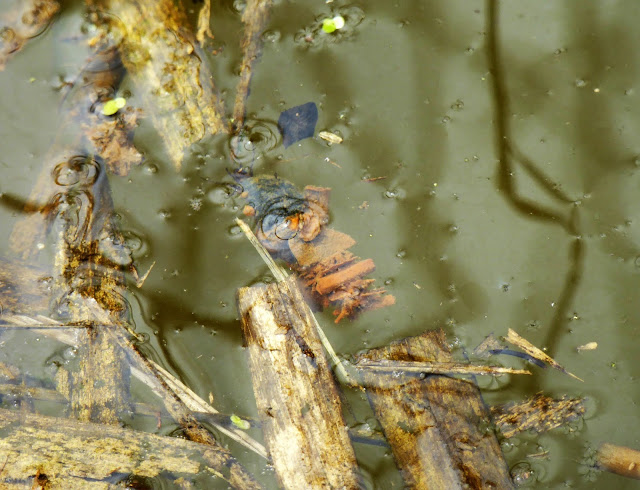 |
| 'Meeter and Greeter' at the reserve |
We had a good look in the water channels and were pleased to see this Caddisfly larva (do look at more pictures here) moving about in the bits of twig and reed. These creatures fascinate us: this insect gains high marks for recycling!
There were a few Peacock butterflies fluttering hither and thither in the burst of sunshine and resting on the sandy ground.
This is one of two Tern Islands, specially created for these pelagic birds. It would be good to see it is use another time...
What a lovely position for the new hide. As you can see, the tide was pretty high when we reached the intertidal zone.
Can you spot the singer in the leaves?

There were Nightingales, Cetti's warbler, Chiffchaff and a few Blackcaps about.
This squirrel has a choice perch, overlooking the estuary and the stretch of marsh and water that divides Mersea Island from the mainland. A solitary Goldfinch was making the most of the seeds.
This bit of recycling was done by humans: I love the way in which the feeders and old plough all sit together.
View... with sails
Insects were well provided for: this was a pretty impressive insect hotel. There were some colourful and beautifully decorated (small) ones in the shop. I know birds are better with plain houses, but does anyone know if insect ones can safely be painted? Mine are a little the worse for wear and could do with a lick of something bright.
One of the residents - and there were also two lambs skittering about.
I watched this little fellow having a good preen up in the branches
The site has 300 species of wild flower!
 |
| Wild Pansy (tiny) |
There were some lovely new signs about - and more seats than I remember, which I always think is an excellent thing to find in a reserve. Some benches had glorious views over the estuary.
There has been some discussion as to the species of these birds. A reserve staff member, with RSPB book to hand, said he thought they were Godwits. A person in the hide suggested Sanderling.
I am drawn to Bar-tailed Godwits for the majority of the birds (Oystercatchers, apart). Male Godwits in breeding plumage develop a russet colour during the breeding season. As the tide came in, we watched the island disappear.
I believe the word 'murmuration' only applies to Starlings! What would we call these wader spectacles?
A view of the watery landscape, complete with ship making headway upstream.
Not so little 'Little Egret'...
And a final note on the name. 'Hoe' refers in Old English to a spur of land. We find it in 'Sutton Hoo', 'Wivenhoe' and 'Grimshoe (Mound)', to name but three examples of its use. 'Wick' meant a trading place or farm to Anglo-Saxons and Vikings. The word sometimes appears as 'wich' (as in Sandwich or Norwich). I understand it may mean 'bay' in Nordic languages: 'wick' and 'Vik'(ing) are not a million miles apart.


















































